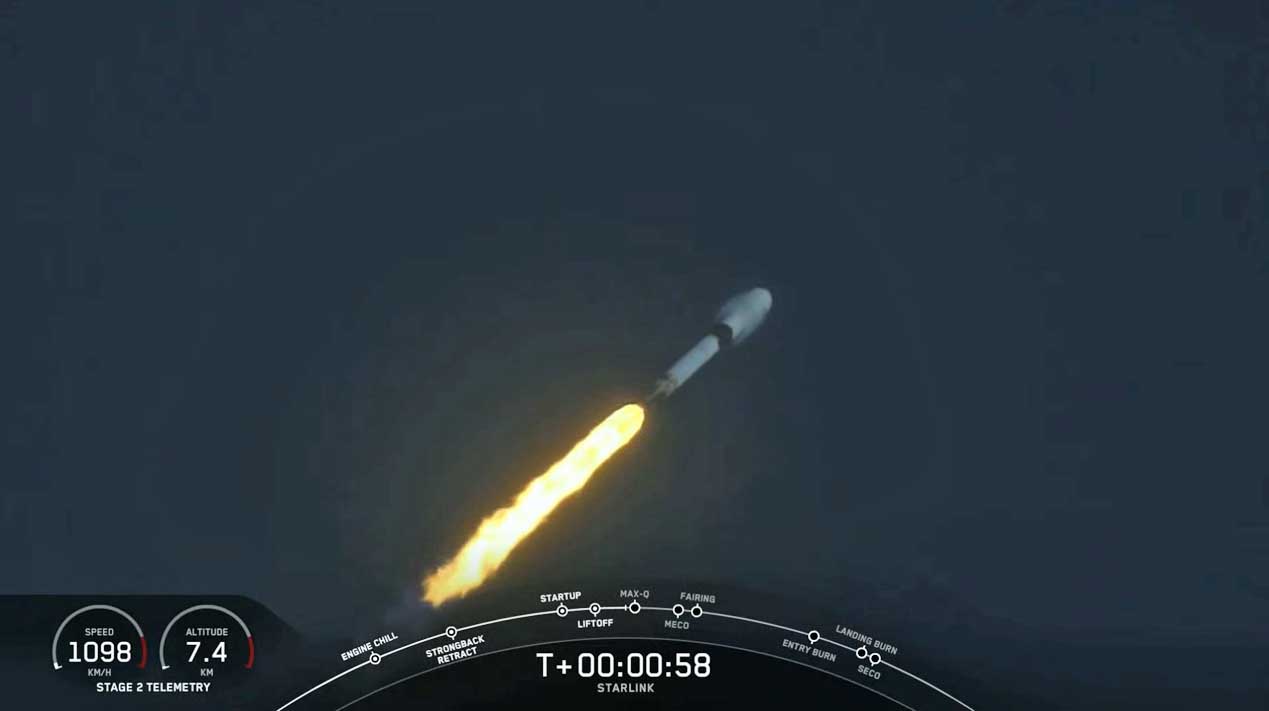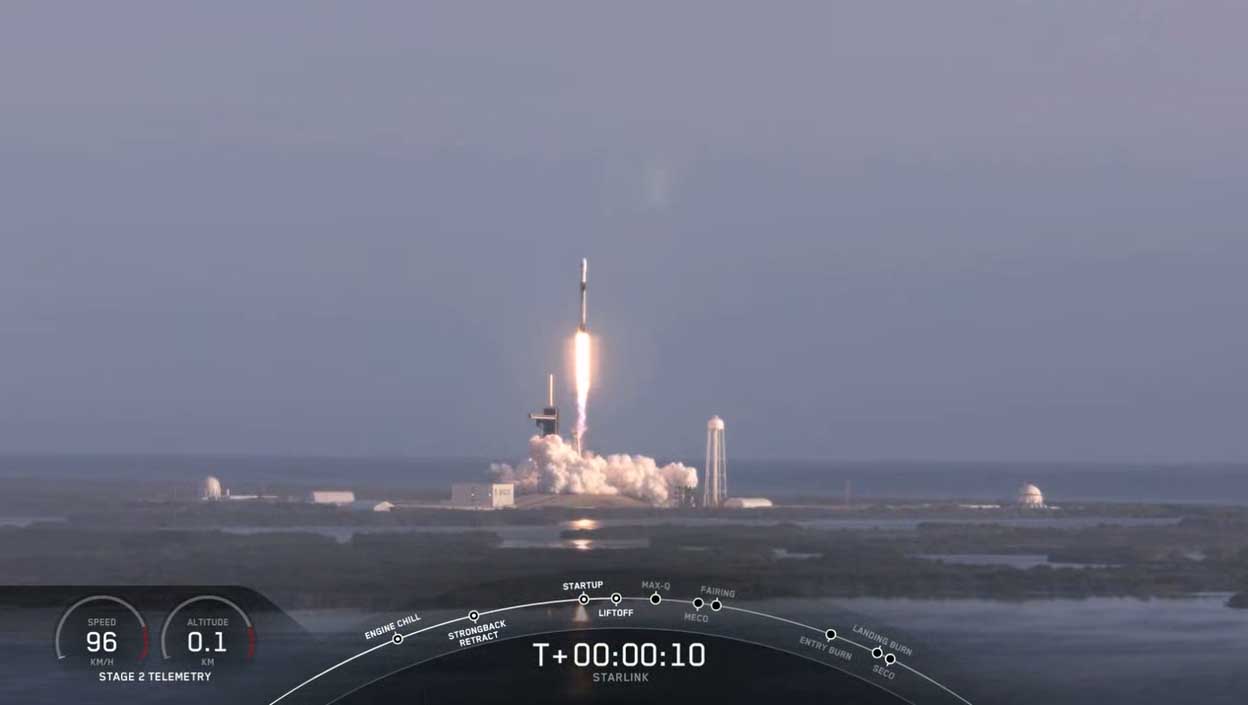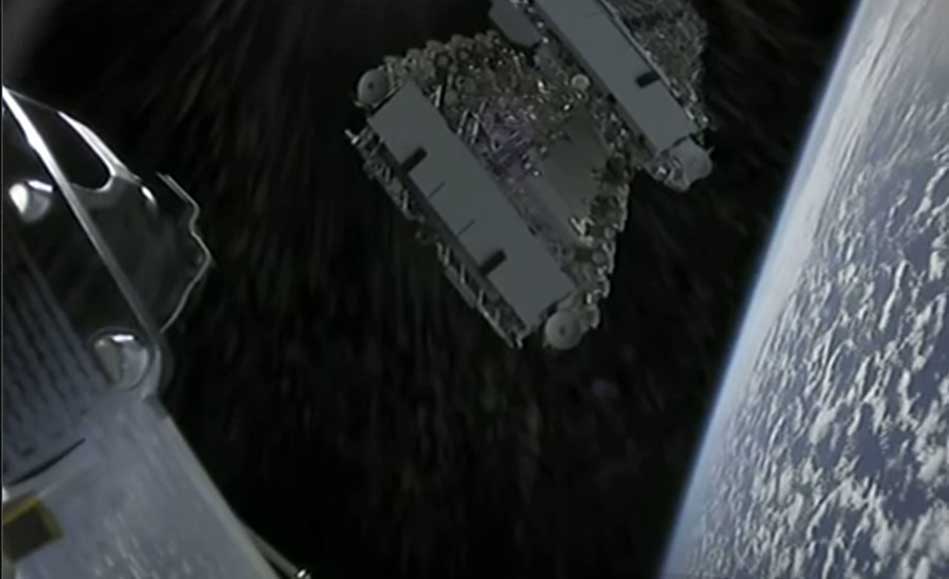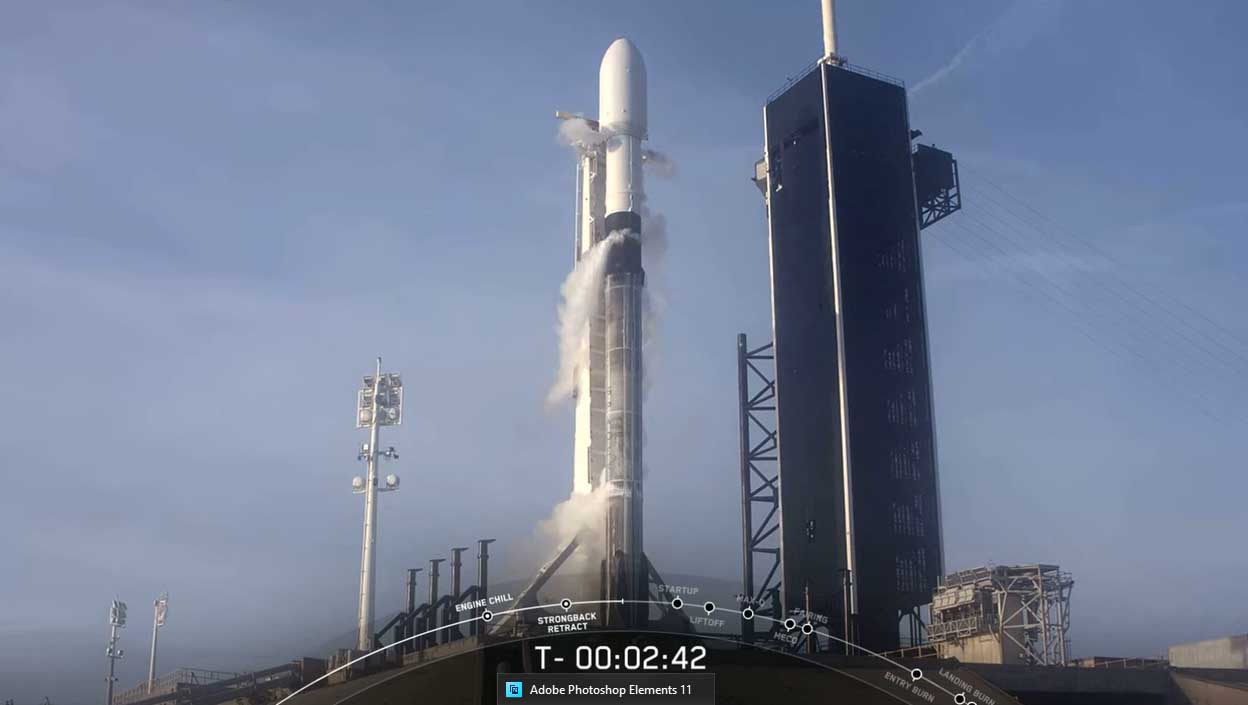SpaceX launches 60 Starlink satellites into orbit, misses rocket landing
The Falcon 9 rocket had launched a record 5 times.
CAPE CANAVERAL, Fla. — SpaceX successfully launched a new batch of 60 Starlink satellites into orbit today (March 18), despite an engine cutout during the flight, but was unable to stick a rocket landing at sea to cap the mission.
The extra sooty Falcon 9 — which made a record fifth launch with today's flight —lifted off at 8:16 a.m. EDT (1216 GMT) from Launch Pad 39A at NASA's Kennedy Space Center here in Florida, its white exterior marred by its four previous trips through the atmosphere.
SpaceX CEO Elon Musk said the Falcon 9 experienced the loss of one of its nine engine during the trip to space, but was still able to deliver its Starlink satellite haul into orbit.
"There was also an early engine shutdown on ascent, but it didn't affect orbit insertion," Musk wrote on Twitter after the launch. "Shows value of having 9 engines! Thorough investigation needed before next mission."
An attempt to land the Falcon 9's first stage in the Atlantic Ocean on SpaceX's drone ship "Of Course I Still Love You" was not successful.
"Our first stage successfully separated from the second stage, but unfortunately we did get confirmation that we were not able to land that first stage today," SpaceX manufacturing engineer Jessica Anderson said during live launch commentary. While that was disappointing, she added, but the primary Starlink mission went on as planned.
Today's on time liftoff came three days after SpaceX's first attempt. That initial flight was postponed when an engine issue triggered a last-second abort.
Get the Space.com Newsletter
Breaking space news, the latest updates on rocket launches, skywatching events and more!
Related: See the evolution of SpaceX's rockets in pictures
Yeah. There was also an early engine shutdown on ascent, but it didn’t affect orbit insertion. Shows value of having 9 engines! Thorough investigation needed before next mission.March 18, 2020

A SpaceX Falcon 9 rocket soars toward space carrying 60 new Starlink satellites, the sixth batch of internet satellites for the company, on March 18, 2020.

A SpaceX Falcon 9 rocket launches 60 of the company's Starlink internet satellites for a growing constellation from Pad 39A of NASA's Kennedy Space Center in Cape Canaveral, Florida on March 18, 2020.

SpaceX deploys 60 new Starlink internet communications satellites into orbit from a Falcon 9 rocket upper stage following a successful launch from Pad 39A of NASA's Kennedy Space Center in Cape Canaveral, Florida on March 18, 2020.

SpaceX's Starlink-5 mission Falcon 9 rocket on the launchpad. The rocket's first stage made its fifth flight during its March 18, 2020 launch.
It was a foggy morning on the space coast, but luckily the fog cleared just before liftoff. The rocket's nine Merlin 1D engines lit up the morning sky as the rocket climbed towards orbit, the rumble from the engines setting off nearby car alarms.
Today’s flight also marks the sixth time a batch of Starink satellites have been deposited into orbit, bringing the total number of satellites to more than 350. The company has several more Starlink missions planned for this year, with an additional 180 satellites due to launch.
According to the program's website, SpaceX plans on rolling out that coverage to the United States and Canada sometime this year. With one more flight, the company could potentially have the minimum number of satellites to do so, as Musk previously said that the company needs somewhere between 400 and 800 satellites in orbit to begin offering its service.
SpaceX's new rocket reflight record
The satellites rode into space atop a veteran Falcon 9 first stage, marking the first time the company has flown a booster five times. The booster, dubbed B1048.5 by SpaceX, previously launched three different communications satellites as well a previous Starlink mission.
"Yeah, most reflights ever!" Musk exclaimed on Twitter after the launch.
SpaceX introduced the rocket that flew today — an upgraded version of its Falcon 9, called the Block 5 — back in 2018. This souped up version was designed to help the aerospace company achieve its reusability goals. Each block 5 Falcon is designed to fly 10 times with little refurbishment in between flights, and 100 times before the vehicle would be retired.
Yeah, most reflights ever!March 18, 2020
This particular first stage first flew in July 2018, when it lofted a batch of Iridium satellites into orbit. Its next mission, the launch of an Earth observation satellite for Argentina, followed less than three months later. The next two flights occurred in 2019, with one in February and one in November.
But that's not good enough for SpaceX. Musk frequently laments that he would like to see space travel emulate air travel. Meaning, all the rocket would do is gas up between flights. In that same vein, Musk has a lofty goal for the company: to see the same Falcon 9 launch and land and launch again within the same 24-hour period.
SpaceX is not quite there yet.
This particular first stage has averaged about four months between flights. The shortest turnaround time for any booster is two months. That's because after each flight, engineers and technicians have to go in and inspect everything to make sure it’s in working order, SpaceX representatives have said. However, the team is continually learning, so as they gain more flight data (especially after multiple flights of the same vehicle), they can better determine what does and doesn’t need to be inspected each time, they added.
Ultimately, the company would like to see down time reduced to just 30 days.
SpaceX's philosophy has always been that a fully reusable rocket is the key to reducing the cost of space flight. To that end, the company designed its workshore — the Falcon 9 — to be reusable.
Initially the company worked to recover the most expensive part of its rocket: the first stage. According to Musk, the first stage accounts for nearly 60% of the vehicle’s cost. To date, SpaceX has recovered 51 first stage boosters, including today’s.
But SpaceX isn't stopping there. It wants to reuse as much of the rocket as possible.
Recovering rocket payload fairings
Currently, a Falcon 9 rocket costs around $62 million, and even though SpaceX has been successful in reusing its first-stage boosters, Musk would like to get to the point where much more is reused, leaving the fuel as the only major expense.
To that end, SpaceX is also attempting to recover and reuse the payload fairings — the protective nose cone that shields the rocket’s cargo as it travels through the atmosphere — with the help of a pair of recovery vessels equipped with giant nets.
Each fairing costs about $6 million, accounting for approximately one-tenth of the vehicle’s overall cost. Historically this hardware has been disposable, but the ability to recover and reuse them would be a big win for SpaceX.
To facilitate reuse, the Falcon 9's fairings are programmed to navigate themselves back to Earth, and equipped with a parachute that enables them to touch down gently either in the ocean or in the outstretched net of a recovery vessel.
Acting as a mobile catcher's mitt, the two vessels — dubbed GO Ms. Tree and GO Ms. Chief — are designed to catch the fairings as they glide back to Earth. To date, GO Ms. Tree has made three successful catches, while GO Ms. Chief has yet to snag a falling fairing.
During today's launch, SpaceX's recovery boats were unable to catch the falling payload fairings, but did manage to quickly pull them from the ocean.
"Today’s Falcon 9 launch was the second time SpaceX has re-flown a full payload fairing," SpaceX representatives wrote in a Twitter update. "After landing in the water, both fairing halves were quickly recovered."
Today’s Falcon 9 launch was the second time SpaceX has re-flown a full payload fairing. After landing in the water, both fairing halves were quickly recovered. pic.twitter.com/JF9y7yrkxpMarch 18, 2020
SpaceX is continually pushing the boundary of reuse. With this mission, in addition to flying a Falcon 9 five times, the company is also reusing the payload fairings. Both pieces were previously flown on the very first Starlink mission back in May 2019.
Following that launch, they were scooped out of the ocean, refurbished, and flown again. That means the only major piece of hardware that’s new is the rocket's upper stage.
- In Photos: SpaceX launches third batch of 60 Starlink satellites to orbit
- SpaceX's Starlink broadband service will begin in 2020: Report
- Why SpaceX's Starlink satellites caught astronomers off guard
Follow Amy Thompson on Twitter @astrogingersnap. Follow us on Twitter @Spacedotcom or Facebook.
OFFER: Save at least 56% with our latest magazine deal!
All About Space magazine takes you on an awe-inspiring journey through our solar system and beyond, from the amazing technology and spacecraft that enables humanity to venture into orbit, to the complexities of space science.
Join our Space Forums to keep talking space on the latest missions, night sky and more! And if you have a news tip, correction or comment, let us know at: community@space.com.

Amy Thompson is a Florida-based space and science journalist, who joined Space.com as a contributing writer in 2015. She's passionate about all things space and is a huge science and science-fiction geek. Star Wars is her favorite fandom, with that sassy little droid, R2D2 being her favorite. She studied science at the University of Florida, earning a degree in microbiology. Her work has also been published in Newsweek, VICE, Smithsonian, and many more. Now she chases rockets, writing about launches, commercial space, space station science, and everything in between.
-
Awesome1 Reply
The extra sooty Falcon 9 is right. I was watching a lift off from 75 miles away and watched an upside down huge black funnel cloud falling back to earth. When I researched I found out 50 tons, that's 100,000 pounds of carbon, is produced by each Falcon 9 kerosene rocket launchAdmin said:SpaceX successfully launched a new batch of 60 Star satellites into orbit today (March 18), but was unable to stick a rocket landing at sea to cap the mission.
SpaceX launches 60 Star satellites into orbit, misses rocket landing : Read more -
Melonhead Anyone have any ideas what the object was flying by the first stage at about 6:40? Or, maybe to be more accurate, what the object was that the first stage went flying by?Reply -
homer3.415192 Reply
Yes, I grabbed some screen shots. It came from way ahead of the first stage, and went on by. I'm kind of thinking balloon, but not really. Maybe parachute? Hmmm...Melonhead said:Anyone have any ideas what the object was flying by the first stage at about 6:40? Or, maybe to be more accurate, what the object was that the first stage went flying by? -
homer3.415192 Reply
Did you see the object go flying by?wallypalo said:Does anyone know if the fairings were captured this time?










